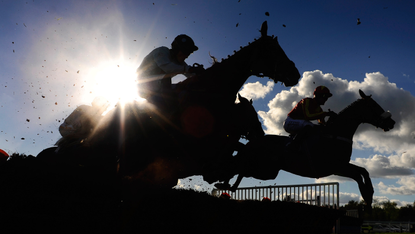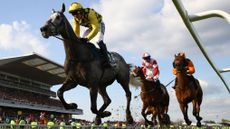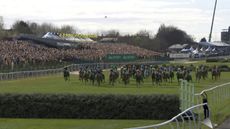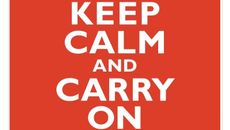Why are thousands of racehorses being shot?
Racing braces itself for backlash as documentary appears to show widespread maltreatment of horses

At least 4,000 racehorses have been slaughtered in Britain and Ireland since the beginning of 2019, a new documentary claims.
The racing community is “bracing itself for a backlash”, says The Telegraph, ahead of the Panorama documentary The Dark Side of Horse Racing airing on BBC1 at 8.30pm this evening.
Covert footage captured by animal rights group Animal Aid over a four-day period at F Drury and Sons, one of the UK’s biggest abattoirs and situated just outside Swindon, appears to show how rules that ought to protect horses from unnecessary cruelty are “regularly ignored”, the BBC reports.
Subscribe to The Week
Escape your echo chamber. Get the facts behind the news, plus analysis from multiple perspectives.

Sign up for The Week's Free Newsletters
From our morning news briefing to a weekly Good News Newsletter, get the best of The Week delivered directly to your inbox.
From our morning news briefing to a weekly Good News Newsletter, get the best of The Week delivered directly to your inbox.
The broadcaster states that a number of the horses shot at the slaughterhouse include several who “had previous illustrious racing careers, winning thousands of pounds”. “Most” of the horses on camera were from Ireland, The Telegraph reports.
Career-ending injuries
Injuries can end a horse’s racing career, and a broken leg can be a death sentence. The British Horseracing Authority (BHA) says that “often the kindest way to help a horse with a broken limb is to put it down” due to the animals’ “complex physiology”.
A broken leg can “cause damage to blood vessels and other tissue” and, having evolved as a prey animal, horses need to stay on their feet most of the time, which can prevent healing. Should an injury prove to be career-ending, it is common practice that horses are sent to an abattoir licensed to slaughter horses.
Slaughterhouses are required to follow government legislation on the humane killing of animals, including horses. The Welfare of Animals (Slaughter or Killing) Regulations states: “No person shall engage in the movement, lairaging, restraint, stunning, slaughter or killing of any animal unless he has the knowledge and skill necessary to perform those tasks humanely and efficiently.”
However, the documentary appears to show clear breaches of these requirements. One regulation states that horses should not be killed in sight of one another, but the broadcaster says that the footage shows 26 incidents of horses being shot together. Another states that slaughtering should ensure a rapid death, “but the footage showed that sometimes the death was far from instant”.
“If you’re going to euthanise a horse, you’ve got to get a bullet in the right place,” Professor Daniel Mills, a specialist in veterinary behavioural medicine, tells the programme. Discussing the footage, which appears to show 91 occasions when horses are shot from a distance, Mills said: “If that’s representative of how they’re being killed, then we’ve got a really serious problem.”
The alleged transportation of racehorses over more than 350 miles from Ireland to the Drury abattoir in Swindon could prove to be a further breach of the government regulations, the BBC reports. Dr Hannah Donovan, a veterinary expert, says that travelling such a distance while “potentially carrying an injury is not a humane process”.
Donovan also states that if horses need to be put down, they “could and should be euthanised at home”.
What will happen next?
Animal Aid’s Dene Stansall, a horse racing consultant, said that the sport’s “poor welfare record” as well as “the number of horses dying and being killed in slaughterhouses” may cause members of the public to change their opinion of horse racing. Founded in 1977, Animal Aid campaigns for an outright ban on horse racing and the end of slaughtering animals for food products.
The Panorama documentary will also show what appears to be three horses in the abattoir that were previously trained by Gordon Elliott, although the three times Grand National winning trainer says he did not send any of the animals to F Drury and Sons.
Elliott has been suspended from the sport since March 2021 after a photograph that showed him sitting on a dead horse shocked the racing community. His ban is set to be lifted on 9 September this year, and The Telegraph reports that “the first time Elliott learnt of the three horses’ fate was when Panorama contacted him”.
The BHA has said it will “consider carefully any issues raised” by the documentary, which could lead to a review of the current regulations and practices for killing racehorses.
F Drury & Sons told Panorama: “We take great care to maintain high welfare conditions and do not accept any form of animal abuse. All horses are humanely destroyed and on occasions where issues do occur, we take swift action to review and rectify.”
Create an account with the same email registered to your subscription to unlock access.
Sign up for Today's Best Articles in your inbox
A free daily email with the biggest news stories of the day – and the best features from TheWeek.com
Julia O'Driscoll is the engagement editor. She covers UK and world news, as well as writing lifestyle and travel features. She regularly appears on “The Week Unwrapped” podcast, and hosted The Week's short-form documentary podcast, “The Overview”. Julia was previously the content and social media editor at sustainability consultancy Eco-Age, where she interviewed prominent voices in sustainable fashion and climate movements. She has a master's in liberal arts from Bristol University, and spent a year studying at Charles University in Prague.
-
 The murky role of military contractors in war
The murky role of military contractors in warThe Explainer A civil case against US company has revived debate over the increasing use of private security firms in military operations
By Richard Windsor, The Week UK Published
-
 The week's best photos
The week's best photosIn Pictures Playful goslings, an exploding snowman, and more
By Anahi Valenzuela, The Week US Published
-
 What is rock flour and how can it help to fight climate change?
What is rock flour and how can it help to fight climate change?The Explainer Glacier dust to the rescue
By Devika Rao, The Week US Published
-
 Grand National: will safety changes work?
Grand National: will safety changes work?Talking Point UK's most famous horse race brings in new welfare measures amid increased scrutiny
By The Week Staff Published
-
 Sam Waley-Cohen: ‘a fairy tale, a fantasy’ at the Grand National
Sam Waley-Cohen: ‘a fairy tale, a fantasy’ at the Grand NationalWhy Everyone’s Talking About The amateur jockey won his last ever race riding 50-1 shot Noble Yeats
By The Week Staff Published
-
 2022 Grand National guide: runners, top tips, latest odds and how to pick a winner
2022 Grand National guide: runners, top tips, latest odds and how to pick a winnerfeature The runners and riders have been confirmed for Saturday’s race at Aintree
By Mike Starling Last updated
-
 Virtual Grand National 2020 guide: runners, betting odds, start time, TV channel
Virtual Grand National 2020 guide: runners, betting odds, start time, TV channelIn Depth Tiger Roll is the favourite to win the CGI version of the big race at Aintree
By The Week Staff Last updated
-
 Today’s back pages: England’s Three Lions are caged for a year and the Grand National and Boat Races are cancelled
Today’s back pages: England’s Three Lions are caged for a year and the Grand National and Boat Races are cancelledDaily Briefing A round-up of the sport headlines from UK newspapers on 17 March
By The Week Staff Published
-
 Cheltenham Festival: Altior pulls out of Champion Chase
Cheltenham Festival: Altior pulls out of Champion ChaseSpeed Read The biggest week in racing gets underway, but star horse is forced to withdraw
By The Week Staff Published
-
 Sports shorts: Chelsea and Barcelona to play behind closed doors, Cheltenham under way
Sports shorts: Chelsea and Barcelona to play behind closed doors, Cheltenham under wayDaily Briefing Ten things from the world of sport on Tuesday 10 March
By The Week Staff Published
-
 Back pages: calls for coronavirus calm as Cheltenham begins, Marler faces rap
Back pages: calls for coronavirus calm as Cheltenham begins, Marler faces rapSpeed Read A round-up of the sport headlines from UK newspapers on 10 March
By The Week Staff Published